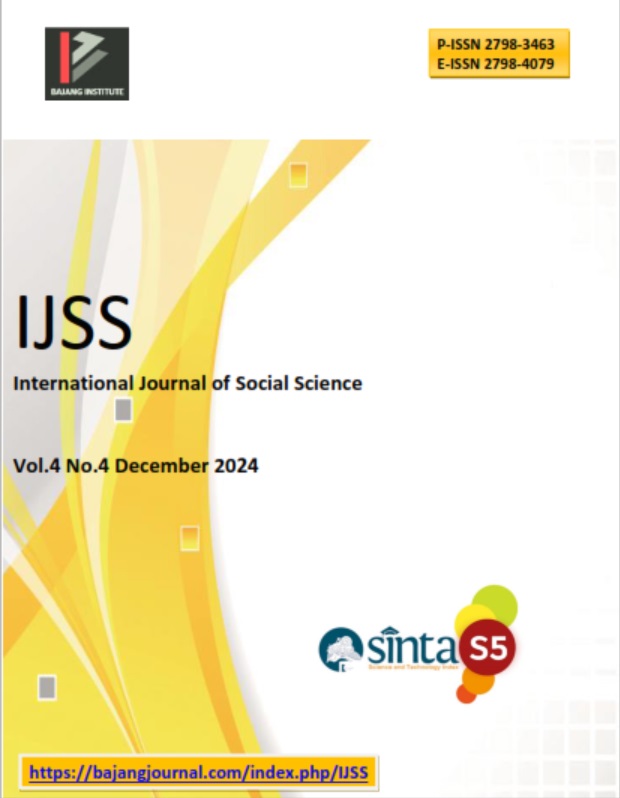ENGLISH LANGUAGE TEACHING IN INDONESIA
DOI:
https://doi.org/10.53625/ijss.v4i4.9256Keywords:
English, English Language Teaching, World Englishes, IndonesiaAbstract
This paper reports on the English Language Teaching (ELT) in Indonesia and the significance of a proposed approach to the ELT, that is, World Englishes. Library research was conducted to answer principal questions regarding “which prestigious variety should be used, the local English teacher (non-native English teacher) and inner-circle teacher debate (native English teacher), and impact of English affecting local languages. The report concludes with recommendations on how to deal with the three issues”. The first recommendation is to incorporate World Englishes teaching method into ELT in educational institutions nationwide hence provide first-hand experience of varieties of Englishes used in other countries. Secondly, it was suggested that it is more efficient to have both native and non-native English Teachers to teach at a language institution. Lastly, as English travels worldwide it may affect heritage languages thus Jenkins (2015) proposes, students should be made aware of their native languages as their identities and function it together with English (Jenkins, 2015, p. 176). Ultimately, bilingualism is essential in order to employ English as the international language but not forgetting to maintaining local languages as students’ important cultural asset
References
Bailey, R. W. (2011). Speaking American English: A History of English in the United States. Oxford: Oxford University Press.
Butler, Y. (2007). How Are Nonnative-English-Speaking Teachers Perceived by Young Learners? TESOL Quarterly, 41(4), 731-755. Retrieved from http://www.jstor.org.ezproxy.lib.monash.edu.au/stable/40264404
Canagarajah, S. C. (1999). Resisting Linguistic Imperialism in English Teaching. Oxford: Oxford University Press.
Coleman, H. (2016). The English Language as Naga in Indonesia. In Bunce, et al (Eds), Why English: Confronting the Hydra (pp. 59-71). Great Britain: Channel View Publications.
Cook, V. (2001). Second Language Learning and Language Teaching. 3rd edn. London: Arnold.
Global business Indonesia guide. (2017). Private Education in Indonesia – International Schools on the Rise. Retrieved from http://www.gbgindonesia.com/en/education/article/2014/private_education_in_indonesia_international_schools_on_the_rise.php
Grant. (2011). Teaching English in Indonesia. Retrieved from http://www.eslbase.com/countries/indonesia
Groeneboer, K. (1998). Gateway to the west: The Dutch language in colonial Indonesia 1600–1950 (M. Scholz, Trans.). Amsterdam: Amsterdam University Press.
Jenkins, J. (2015). Global Englishes. A resource Book for Students. 3rd edn. London: Routledge.
Kam, H. W & Wong, R.Y.L. (2004). English language teaching in East Asia today: changing policies and practices. Singapore: Eastern Universities Press.
Kirkpatrick, A. (2007). World Englishes – Implications for International communication and English Language Teaching. United Kingdom: Cambridge University Press.
MacArthur, T. (ed.). (1992). The Oxford companion to the English language. Oxford: Oxford University Press.
Mckay, S. L. (2002). Teaching English as an International Language. Oxford: Oxford University Press.
Manns, H. (2017). The birth of English and Variation in the UK [PowerPoint slides]. Retrieved from http://moodle.vle.monash.edu/course/view.php?id=36164§ion=2
Medgyes, P. (1992). Native or non-native: who’s worth more? Journal of English Language Teaching 46 (4), 340-9
Mistar, J. (2005). Teaching English as a foreign language (TEFL) in Indonesia. In George, B (Ed.), Teaching English to the World: History, Curriculum, and Practice (168-188). New York: Taylor and Francis.
Nordquist, R. (2016). American English. Retrieved from https://www.thoughtco.com/linguistic-prestige-1691533.
Nordquist, R. (2017a). Linguistic Prestige. Retrieved from https://www.thoughtco.com/american-english-ame-1688982
Nordquist, R. (2017b). Received Pronunciation. Retrieved from https://www.thoughtco.com/received-pronunciation-rp-1692026
Nordquist, R. (2019). Definitions and Examples of Native Languages. Retrieved from https://www.thoughtco.com/native-language-l1-term-1691336
Onishi, N. (2010, July 25). As English Spreads, Indonesian Fear for Their Language. The New York Times. Retrieved from http://www.nytimes.com/2010/07/26/world/asia/26indo.html
Phillipson, R. (1992). Linguistic Imperialism. Oxford: Oxford University Press.
Sangster, C. RP and BBC English. 2014. Retrieved from http://www.bbc.co.uk/voices/yourvoice/rpandbbc.shtml
Setiawan, A.W. (2012). The Professional Identity of Indonesian Englsih Teachers. Retrieved from https://www.slideshare.net/ardian1978/the-professional-identity-of-indonesian-english-teachers
Simons, G. F & Fennig, C.D. (Eds). (2017). Ethnologue: Languages of the World, (20th edn). Dallas, Texas: SIL International. Retrieved from http://www.ethnologue.com.
Thomas, R. M. (1968). Indonesia: The English-language curriculum. In R. M. Thomas, L. B. Sands, & D. L. Brubaker (Eds.), Strategies for curriculum change: Cases from 13 nations (pp. 279–322). Scranton, Pennsylvania: International Textbook Company.
Downloads
Published
How to Cite
Issue
Section
License
Copyright (c) 2024 Selmina Rumawak

This work is licensed under a Creative Commons Attribution 4.0 International License.

















